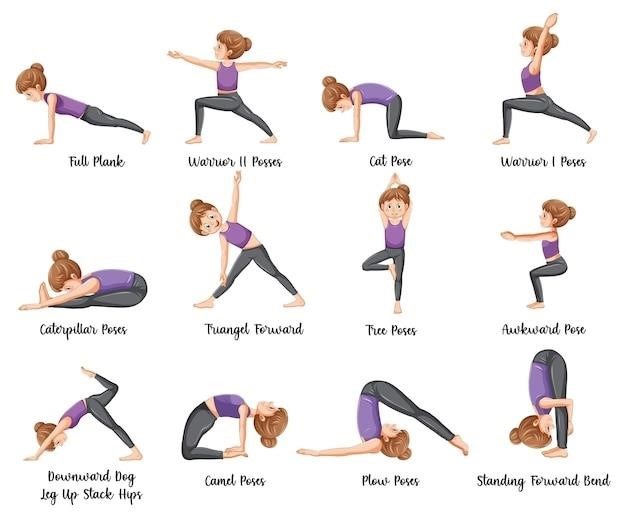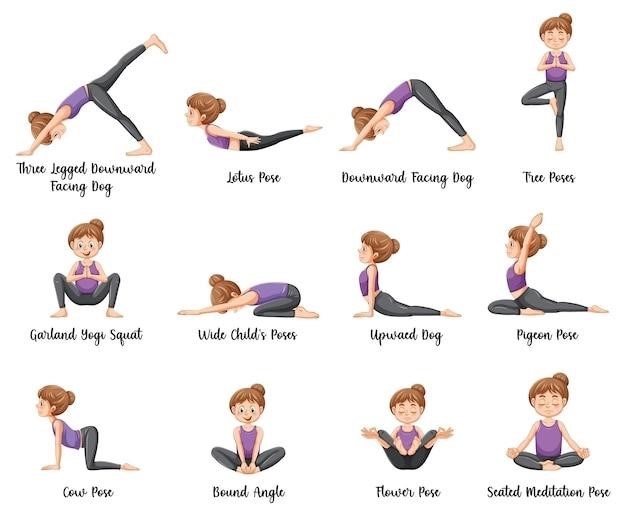Vinyasa Flow Yoga Sequence PDF⁚ A Comprehensive Guide
This comprehensive guide will delve into the world of vinyasa flow yoga, providing a detailed understanding of its principles, benefits, and how to create your own sequences. We will explore the core components of a vinyasa flow, including the foundational vinyasa, and offer a sample sequence for you to practice. Whether you’re a seasoned yogi or just starting your journey, this guide will equip you with the knowledge and tools to unlock the transformative power of vinyasa flow.
Introduction
Welcome to the world of vinyasa flow yoga, a dynamic and invigorating practice that seamlessly blends movement with breath. This comprehensive guide will serve as your roadmap to mastering the art of vinyasa flow, empowering you to create your own sequences and deepen your understanding of this transformative practice. Vinyasa flow, often referred to simply as “flow,” is a style of yoga that emphasizes the smooth transition between poses, creating a continuous and fluid movement that mirrors the rhythm of your breath. The word “vinyasa” translates to “placement” or “arrangement,” and in the context of yoga, it refers to the intentional sequencing of poses and breathwork. This guide will equip you with the knowledge and tools to create your own vinyasa flow sequences, whether you’re a beginner eager to explore the world of yoga or a seasoned practitioner seeking to refine your practice.
Vinyasa flow is more than just a series of poses; it’s a journey of self-discovery and a path to greater awareness. As you move through the poses, you’ll cultivate a deeper connection to your body and breath, enhancing your flexibility, strength, and balance. The synchronized movements and mindful breathing will also promote mental clarity, reduce stress, and foster a sense of inner peace. Get ready to embark on a transformative journey as we explore the intricacies of vinyasa flow, uncovering its secrets and unlocking its full potential.
Understanding Vinyasa Flow
Vinyasa flow yoga is a dynamic practice that emphasizes the seamless transition between poses, creating a continuous and flowing movement that mirrors the rhythm of your breath. The word “vinyasa” translates to “placement” or “arrangement,” and in the context of yoga, it refers to the intentional sequencing of poses and breathwork. This style of yoga is often called “flow” because of the smooth and graceful way the poses are linked together, creating a sense of movement and energy. Unlike traditional Hatha yoga, which focuses on holding poses for extended periods, vinyasa flow encourages continuous movement, often linking poses to the inhale and exhale. This creates a dynamic and challenging practice that not only strengthens the body but also calms the mind.
The foundation of vinyasa flow lies in the concept of the vinyasa, a specific sequence of poses that forms the building blocks of the practice. The most common vinyasa is the Sun Salutation, a series of poses that flow together in a cyclical pattern. This sequence typically includes poses like Mountain Pose, Forward Fold, Plank Pose, Chaturanga, Upward-Facing Dog, Downward-Facing Dog, and various transitions between them. The vinyasa is a powerful tool that helps to warm up the body, build strength and flexibility, and cultivate a sense of mindfulness. By understanding the vinyasa and its variations, you can create your own sequences and explore the infinite possibilities of vinyasa flow.
Benefits of Vinyasa Flow
The benefits of vinyasa flow yoga extend far beyond physical fitness, encompassing both physical and mental well-being. This dynamic practice offers a multitude of advantages that can enhance your overall health and quality of life; Here are some of the key benefits you can expect from incorporating vinyasa flow into your regular routine⁚
- Improved Cardiovascular Health⁚ The continuous movement and rhythmic breathing in vinyasa flow help to increase heart rate and blood flow, strengthening the cardiovascular system and reducing the risk of heart disease.
- Enhanced Strength and Flexibility⁚ The dynamic poses and transitions in vinyasa flow engage multiple muscle groups, building strength and flexibility throughout the body. This practice can help to improve posture, reduce muscle tension, and enhance overall mobility.
- Stress Reduction and Mental Clarity⁚ The rhythmic breathing and focus on the present moment in vinyasa flow can effectively reduce stress and anxiety. This practice helps to quiet the mind, promote relaxation, and enhance mental clarity.
- Increased Body Awareness⁚ Vinyasa flow encourages a deep connection between your body and mind. The mindful movement and transitions help you to become more aware of your body’s sensations, alignment, and limitations, fostering a greater sense of self-understanding.
- Boost in Energy and Vitality⁚ The flowing movements and breathwork in vinyasa flow can invigorate your body and mind, leaving you feeling energized and refreshed. This practice can help to combat fatigue, boost your mood, and enhance your overall vitality.
Vinyasa flow yoga is a holistic practice that offers a wide range of benefits for both body and mind. By incorporating this dynamic style of yoga into your routine, you can experience improved physical fitness, reduced stress, enhanced mental clarity, and a greater sense of well-being.
Key Components of a Vinyasa Flow Sequence
Vinyasa flow yoga sequences are carefully crafted to create a dynamic and transformative experience. They are built upon a foundation of key components that work together to enhance strength, flexibility, and mindfulness. Understanding these components will help you to better appreciate the structure and intention behind a vinyasa flow sequence.
- Sun Salutations (Surya Namaskar)⁚ Sun salutations are the cornerstone of most vinyasa flow sequences. They consist of a series of poses linked together by breath, creating a flowing warm-up that prepares the body and mind for the practice. There are several variations of sun salutations, each offering unique benefits and challenges.
- Vinyasa⁚ The term “vinyasa” refers to the linking of breath and movement, creating a seamless transition between poses. The basic vinyasa flow is a sequence of poses often repeated throughout the practice, including Plank, Chaturanga, Upward-Facing Dog, and Downward-Facing Dog. This sequence is a building block for more complex flows.
- Standing Poses (Standing Series)⁚ Vinyasa flow sequences often include a series of standing poses, such as Warrior I, Warrior II, Triangle Pose, and Half Moon Pose. These poses challenge balance, strength, and flexibility, while building heat and energy in the body.
- Seated Poses (Seated Series)⁚ Seated poses, such as Cross-legged Sit (Sukhasana), Forward Fold (Uttanasana), and Seated Spinal Twist (Parivrtta Sukhasana), are often incorporated into vinyasa flow sequences to promote flexibility, calm the mind, and provide a sense of grounding.
- Backbends⁚ Backbends, like Cobra Pose (Bhujangasana) and Camel Pose (Ustrasana), are often included in vinyasa flow sequences to open the chest, improve posture, and increase flexibility in the spine.
- Inversions⁚ Inversions, such as Downward-Facing Dog (Adho Mukha Svanasana) and Headstand (Shirshasana), are often included in vinyasa flow sequences to increase blood flow to the brain, calm the nervous system, and enhance balance.
- Restorative Poses (Savasana)⁚ Vinyasa flow sequences typically conclude with a period of deep relaxation in Savasana (corpse pose). This allows the body and mind to integrate the benefits of the practice and promote a sense of peace and tranquility.
By understanding these key components, you can begin to appreciate the intricate structure and intention behind vinyasa flow sequences. As you continue to practice, you will develop a deeper understanding of how these elements work together to create a transformative and rewarding experience.

Sample Vinyasa Flow Sequence
This sample vinyasa flow sequence is designed to be accessible for beginners while offering a balanced and invigorating experience. It incorporates key components of a vinyasa flow, including sun salutations, standing poses, backbends, and inversions, and concludes with a restorative period in Savasana. Remember to listen to your body, modify poses as needed, and breathe deeply throughout the practice.
- Warm-up⁚ Begin with 5-10 minutes of gentle warm-up, such as Cat-Cow Pose (Marjaryasana-Bitilasana), Child’s Pose (Balasana), and Downward-Facing Dog (Adho Mukha Svanasana).
- Sun Salutations (Surya Namaskar)⁚ Perform 3-5 rounds of Sun Salutations to build heat and energy in the body.
- Standing Series⁚ Flow through a series of standing poses, such as Warrior I (Virabhadrasana I), Warrior II (Virabhadrasana II), Triangle Pose (Trikonasana), and Half Moon Pose (Ardha Chandrasana).
- Backbends⁚ Incorporate a few backbends, such as Cobra Pose (Bhujangasana) and Camel Pose (Ustrasana), to open the chest and promote flexibility in the spine.
- Inversions⁚ Spend some time in inversions, such as Downward-Facing Dog (Adho Mukha Svanasana) and a supported Forward Fold (Uttanasana), to increase blood flow to the brain and calm the nervous system.
- Seated Series⁚ End with a few seated poses, such as Cross-legged Sit (Sukhasana), Forward Fold (Uttanasana), and Seated Spinal Twist (Parivrtta Sukhasana), to promote relaxation and grounding.
- Savasana (Corpse Pose)⁚ Rest in Savasana for 5-10 minutes, allowing the body and mind to integrate the benefits of the practice.
This sample sequence can be modified to suit your individual needs and preferences. You can adjust the number of repetitions, hold poses for longer or shorter periods, or add additional poses that you enjoy. The key is to listen to your body and create a practice that feels good for you.
Tips for Practicing Vinyasa Flow
Embarking on your vinyasa flow journey requires mindful attention to both physical and mental aspects. Here are some tips to enhance your practice and foster a deeper connection with your breath and movement⁚
- Listen to Your Body⁚ Vinyasa flow is about finding a harmonious connection between your breath and movement. Pay close attention to your body’s cues and adjust poses as needed. If you feel pain or discomfort, modify or skip the pose and focus on breathing deeply.
- Focus on the Breath⁚ Breathing is the cornerstone of vinyasa flow. Synchronize your movements with your breath, inhaling as you lengthen and exhaling as you release. Allow your breath to guide you through the sequence.
- Engage Your Core⁚ A strong core provides stability and support for your body throughout the practice. Engage your abdominal muscles and keep your core engaged throughout the flow;
- Be Present⁚ Cultivate a sense of presence during your practice. Observe your body sensations, your breath, and your thoughts without judgment.
- Find a Supportive Teacher⁚ Consider taking classes with an experienced vinyasa flow instructor to learn proper alignment, technique, and modifications. A qualified teacher can guide you and help you develop a safe and effective practice.
- Be Patient and Kind⁚ Vinyasa flow can be challenging, but it is a journey of self-discovery. Be patient with yourself and your progress. Be kind to your body and celebrate each step forward.
By following these tips, you can deepen your understanding and appreciation of vinyasa flow, allowing you to cultivate a more balanced and fulfilling practice.
Resources for Further Learning
The journey of vinyasa flow yoga is a continuous exploration, and there are numerous resources available to deepen your understanding and refine your practice. Whether you seek to expand your knowledge of the history, philosophy, or practical applications of vinyasa flow, these resources can provide valuable insights and guidance⁚
- Yoga Teacher Training Programs⁚ Consider enrolling in a reputable yoga teacher training program specializing in vinyasa flow. These programs provide a comprehensive curriculum, including anatomy, physiology, alignment, sequencing, and teaching methodology.
- Yoga Books and Articles⁚ Explore books and articles written by renowned yoga teachers and experts on vinyasa flow; These resources offer detailed explanations of poses, sequences, and the philosophy behind the practice.
- Online Yoga Platforms⁚ Numerous online platforms offer a wide range of vinyasa flow classes, workshops, and resources; These platforms allow you to learn from experienced teachers and access a variety of styles and levels.
- Yoga Communities⁚ Connect with fellow yogis in online forums, social media groups, or local yoga studios. Sharing experiences, asking questions, and learning from others can enrich your practice.
- Yoga Retreats⁚ Consider participating in a vinyasa flow yoga retreat. These retreats offer immersive experiences, allowing you to deepen your practice, learn from experienced teachers, and connect with like-minded individuals.
By immersing yourself in these resources, you can cultivate a deeper understanding of vinyasa flow and embark on a journey of continuous growth and transformation.




Be the first to reply